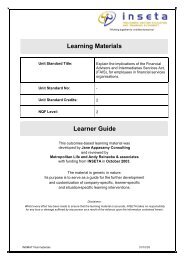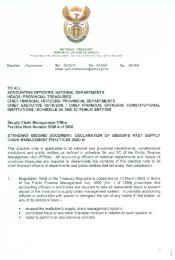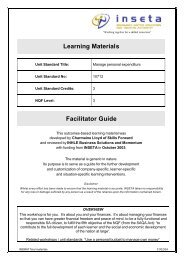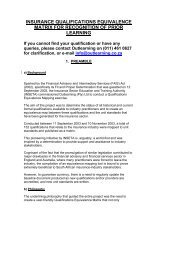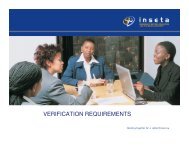1 PROFILE OF THE SECTORThe insurance sector forms part of the large and rapidly growing financial and business services sector in South Africa. In 2006, financialand business services contributed 21.6 % to the national GDP, and in the period 1996 to 2006 they increased their contribution to GDPby more than 3.8%. 2 In March 2006, this sector provided 9.6% of the employment opportunities in the country. 3Insurance plays a major role in the South African economy. In 2006, the net premium income of long-term insurers amounted toapproximately R223 billion 4 and that of short-term insurers to R38.5 billion. 51.1 Industrial coverageThe sector served by the <strong>INSETA</strong> includes providers of insurance products (i.e. long-term and short-term insurers and reinsurers) as wellas the intermediaries or brokers who sell insurance products to the public. The Standard Industrial Classification (SIC) codes that areincluded in the sector can be seen in Table 1-1.Table 1.1 Insurance industry SIC codesSIC code descriptionSIC codeUnit Trusts (or collective investments) 81901Risk Management 81902Insurance and Pension Funding, except compulsory social security 82100Life Insurance 82110Pension Funding 82120Healthcare Benefits Administration 82131Short-term Insurance 82191Funeral Insurance 82192Reinsurance 82193Activities Auxiliary to Insurance and Pension Funding (including brokers/intermediaries) 833001.2 Profile of employers in the sector1.2.1 Total number of employersThe South African insurance industry functions in a highly regulated environment, and most of the organisations that operate in this sectorare subject to legislative requirements for registration with a regulatory body. All insurers, reinsurers, pension funds and collective investmentmanagers have to register with the Financial Services Board (FSB) and since the introduction of the FAIS Act, all intermediaries also haveto register with the FSB. Table 1-2 shows the number of organisations that belong to the insurance sector and that were registered withthe FSB at the end of the 2005/2006 financial year. At that time, 73 long-term and 98 short-term insurers and 12 reinsurers were registeredwith the FSB. A total of 220 pension fund administrators were also registered. At the end of March 2006 12 610 financial service providerswere registered. 6Table 1.2 Organisations registered with the FSB 31 March 2005Type of organisationNLong-term insurers 73Short-term insurers 98Reinsurers 12Pension fund administrators* 220Collective investment managers 33Financial services providers (category 1) (Intermediaries) 12 601Source: Financial Services Board, Annual Report, 2006*Financial Services Board, Annual Report, 2005.All healthcare funders have to register with the Council for Medical Schemes. At the end of the 2005/2006 financial year there were 131medical schemes registered with the Council. However, most of these schemes were administered by medical scheme administrators. Theadministrator market is dominated by five large administrators, who, together, hold 66% of the market. 7A total of 3 800 organisations had paid skills development levies (SDLs) to the <strong>INSETA</strong> in respect of the 2005/2006 financial year. Themajority of these were intermediaries or brokers.2 Statistics South Africa, Statistical Release PO441, 21 May 2007.3 Statistics South Africa, Labour Force Survey, March 2006.4 Financial Services Board, Special Report on the Results of the Long-term Insurance Industry for the period ended March 2007.5 Financial Services Board, Special Report on the Results of the Short-term Insurance Industry for the period ended March 2007.6 FSB Annual Report, 2006.7 Council for Medical Schemes, Annual Report 2005/2006.<strong>INSETA</strong> Sector Skills Plan - page 1
1.2.2 Employers by subsectorA sector-wide survey of employment, scarce and critical skills which was published in 2006 provided the <strong>INSETA</strong> with the opportunity toglean insight into the subsectoral composition of the sector. In the survey organisations were classified into subsectors on the basis of theirown descriptions of their main economic activities. However, this subsector demarcation is not “pure”, as many organisations were involvedin different aspects of insurance. The following subsectors are distinguished:• Collective investments• Life insurance• Pension funding• Healthcare benefits• Short-term insurance• Funeral insurance• Reinsurance• Brokers/Agents• Activities auxiliary to insurance, which include services rendered to the insurance industry such as human resource services, accountingand other financial services, legal and actuarial services, and training and development.• Non-insurance related activities. This refers to activities performed by organisations assigned to the <strong>INSETA</strong> by SARS or the Departmentof Labour (DoL) and that chose not to move to other SETAs. Such organisations found in the survey include debt-collecting firms,micro-lenders and even enterprises such as pawn shops.Table 1-3 shows the distribution of organisations and employees across the ten subsectors. Most (84.5%) of the organisations, werebrokerages or agents who sold insurance products while 9.0% were classified in the category “activities auxiliary to insurance”. Life insuranceand short-term insurance companies constituted only 0.6% and 1.2% respectively of the organisations in the sector. Life insurers were,however, the largest employers in the sector and accounted for 36.5% of all employees; short-term insurers employed 14.5% of the totalworkforce. Brokerages or agencies employed 21.9% of the workers in the sector.Table 1.3 Distribution of organisations and employees according to subsectorSubsectorOrganisationsEmployeesN % N %Collective investments 14 0.4 60 0.1Life insurance 25 0.6 37 442 36.5Pension funding 18 0.5 6 217 6.1Healthcare benefits 57 1.5 6 750 6.6Short-term insurance 45 1.2 14 846 14.5Funeral insurance 27 0.7 3 106 3.0Reinsurance 10 0.3 456 0.4Brokers/Agents 3 278 84.5 22 431 21.9Activities auxiliary to insurance 350 9.0 10 882 10.6Non-insurance related activities 57 1.5 267 0.3Total 3 881 100.0 102 458 100.0Source: Inseta, Survey of Employment, Scarce and Critical Skills in the Insurance Industry, May 2006Table 1-4 shows the extent to which organisations were involved in the different components of insurance at the time of the survey. Noneof the organisations that classified themselves in the collective investments subsector were involved in any other activities. However, 27.4%of the life insurers were also involved in collective investments, 36.2% were involved in the administration of pension funds, 22.2% wereinvolved in the administration of healthcare benefits, 15.4% offered short-term insurance, 51.5% offered funeral insurance and 4.9% indicatedthat they were involved in reinsurance. Similarly, many of the organisations that placed themselves in the healthcare benefits and the shortterminsurance subsectors were involved in other activities as well.<strong>INSETA</strong> Sector Skills Plan - page 2






